Attracting blue jays to your backyard can be a fun and rewarding experience.
These colorful and intelligent birds are a common sight in many parts of the United States and Canada, and they are known for their bold personalities and distinctive calls.
In this article, we will provide 13 tips on how to attract blue jays to your yard.
Whether you are a seasoned bird watcher or just getting started, attracting blue jays to your backyard is a great way to enjoy nature and add a touch of beauty to your outdoor space.
How to Attract Blue Jays?
1. Offer Some Nuts

Putting out roasted, unsalted nuts is a tried-and-true method of attracting blue jays to your bird feeders.
Complete peanuts, along with other seeds, maize, and grains, are a favorite food of these birds.
Their powerful black bills make short work of cracking open nuts and acorns.
Blue jays may be enticed with almost any kind of seed or nut, but you should avoid offering them anything that is very seasoned.
Birds of this species also enjoy a varied diet that includes berries, tiny fruits, sunflower seeds, and insets.
Blue jays will love a Beech or Oak tree as a home because of the abundance of nuts and cover it provides.
2. Use Leaf Litter to Entice Blue Jays
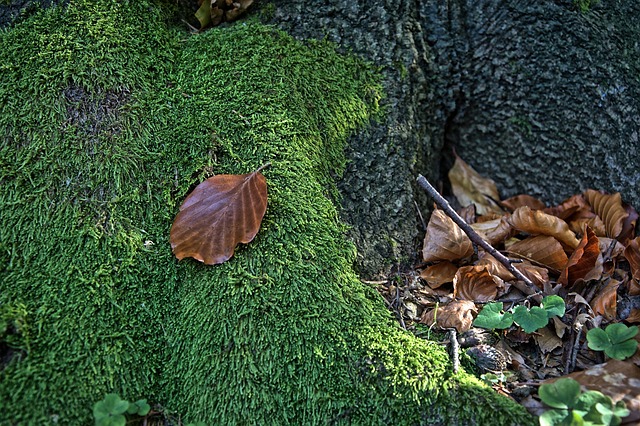
Seeds, nuts, and other food items are hidden by blue jays in tree cavities and beneath loose bark.
If you have a blue jay in your neighborhood, this might take a peanut or nut from your bird feeder and carefully dig it out of the leaf litter beneath your oak tree.
Unfortunately, the jays often forget where they buried the nuts, so hundreds of them are left to germinate the next spring.
However, it’s a good idea to entice blue jays using leaf litter since these stunning birds utilize leaf litter to conceal their fall captures, which will give them the incentive to return to your backyard all through the colder months.
3. Put Up Feeders Designed for Blue Jays
The tray or platform feeder is the most common choice for attracting blue jays. Any hanging feeder that sways or swings are not a good choice for blue jays since they need stability to eat.
Instead, hang or place feeders low to the ground to attract jays with maize, peanuts, suet balls, and sunflower seeds.
To keep these raucous birds content, you may put up suet feeders in addition to the usual fare of seed and grain dishes.
Blue jays are huge birds, so be sure the feeders you choose can handle the birds’ weight and size.
The length of an adult bird ranges from 9 to 12 inches, and its weight from 2.5 to 3.5 ounces.
4. Allow Birds to Nest In Your Backyard
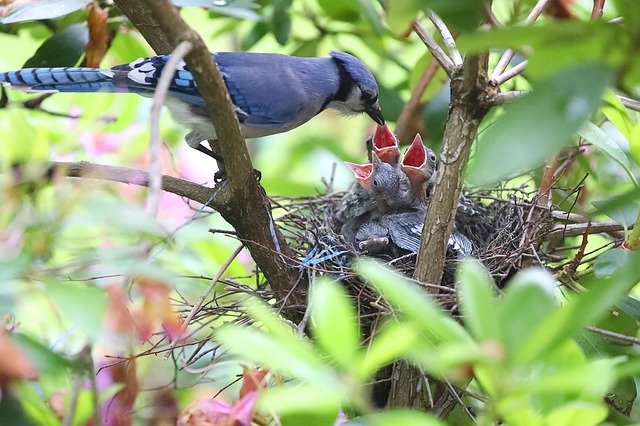
Blue jays usually have many nests because they abandon one at the first sign of danger.
The parents work together to create the nest, with the females primarily responsible for the building and the males for the collecting of materials.
Because blue jays do not nest inside birdhouses, they choose sturdy, mature trees to call home instead.
The female will hatch anywhere from three to seven eggs in a nest she has constructed in the fork of a tree.
You may entice these birds naturally if you live in a wooded area or have huge trees in your backyard that offer them suitable nesting sites.
You may also plant native bushes and trees in your backyard.
Sticks, grass, and twigs clippings may be used as nesting material.
An 8-inch square foundation is recommended for blue jay nesting platforms.
5. The Feeder’s Placement is Crucial
Place your feeder near some bushes or a tree where blue jays may perch and enjoy their food.
As a result of their extreme wariness, these birds are unlikely to visit feeders if people are in the area.
If you’re interested in watching the blue jays at the feeder, do it only from a window and never while sitting there yourself.
Prevent the feeder from getting too much light by placing it in the shade. Birds that are active throughout the day might utilize this time to prepare and store large amounts of food.
Avoid having them spend too much time in the sun by minimizing the distance they must go to achieve their goals.
6. Put Together a “Blue Jay Hot Tub”
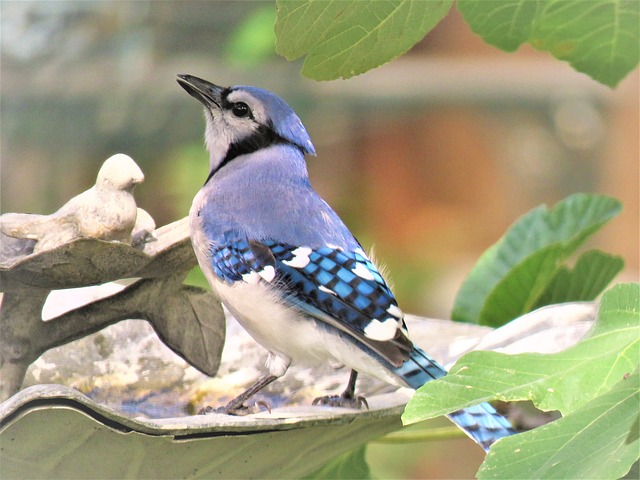
After chowing down on peanuts, even Blue Jays need a cool drink to get them through the day. Nonetheless, they need potable water to drink and relish the opportunity to cool themselves in a spacious spa.
If you want to bring these birds to your backyard, set up some large birdbaths where they can swim and splash.
Since birds like to stick to the same areas year-round, you won’t need to move the birdbath inside for the winter.
More birds, all in quest of water, will flock to your backyard if you install a few bigger baths.
A pedestal birdbath may give a garden a sophisticated aspect, which is why some people choose to put one in their yard.
7. Keep Distance
It bears repeating that blue jays are wary birds that will avoid feeding in the presence of people. As a result of their high territoriality, they often attack cats, dogs, and even people by diving at them.
These birds will demonstrate their displeasure with your presence by avoiding your proximity. But there’s no need to panic; they won’t intentionally collide with you either.
The safest course of action, however, is to either refrain from going near their nest location altogether or to spend as little time as possible there for many days.
If you must be in the vicinity of the recent fledglings, use extreme caution and vigilance.
When it comes to feeding their young, blue jays would always put up a fierce defense.
8. Get Ready for the Breeding Season

The Blue Jay is a monogamous species that stays with its partner for life.
To aid the birds in building a nest during the months of March through July, when they are actively courting and laying eggs, have a stack of sticks and twigs handy.
The blue jays won’t have to make as many journeys back and forth to the nest to get supplies, thanks to this simple adjustment.
To aid them during this time, you may put out bird feeders and other food for these critters to encourage them to stay in your yard.
For hungry jays, you may scatter seeds on the ground or set up a big bird feeder and a ground feeder.
9. Selecting the Correct Vegetation to Attract Jays
Although the returns are modest with this strategy, planting oak trees to attract blue jays is something to think about.
Also, beech trees are a good choice since blue jays like beechnuts. Increasing the number of trees in the yard provides these birds with additional places to nest, perch, and find food.
Blue jays rely heavily on beechnuts and acorns for sustenance, making oak trees, among other nut trees, excellent choices for attracting these birds.
If you want to increase the value of your home and attract more blue jays, plant these trees in your yard.
10. Remove the Possibility of Your Blue Jay Feeders Being Tampered with by Squirrels
Numerous countermeasures exist to prevent squirrels from destroying bird feeders.
Choose squirrel-resistant feeders and methods to protect all of your feeders from these pests.
Securing feeders will prevent wild squirrels from stealing food and will ensure the birds have sufficient to eat.
It’s also a good idea to install a baffle to keep unwanted animals from eating your valuable feed.
You may improve the efficiency of poles or upside-down bowls by installing a baffle.
These fittings wrap the pole’s foundation, obstructing any possible ascent by the squirrels.
Putting up a baffle over a bird feeder can protect it from any potential aerial assaults.
11. Leave Nature to Control Pests
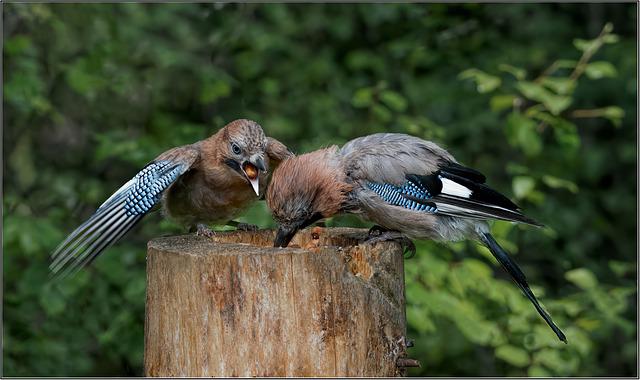
The jays that come to your backyard will provide some of the most amusing moments of the year. There is, however, another crucial role they play.
If the Blue Jays in your neighborhood can reliably find food in your garden or backyard, they will never go.
Blue jays get most of their nutrition from bugs.
They also eat grasshoppers and caterpillars, two frequent garden pests.
If you continue to provide food and shelter to blue jays throughout the year, you may avoid using chemical insecticides.
12. To Deal with Them If They Become Troublesome
Although blue jays may be entertaining to watch and study, they can act aggressively against other birds.
They may be very noisy, and their droppings may be found in and around your yard.
Aggressive birds may drive away other species because they refuse to share their feeders.
These antics, especially when performed by jays, are enough to drive away animals with a high degree of flight avoidance, such as birds of prey.
A blue jay may be scared away without harming the bird in any way.
If the birds are a nuisance, create a feeding area that only the jays can use so the smaller birds may still enjoy the feeders.
13. Offer Them Mealworms
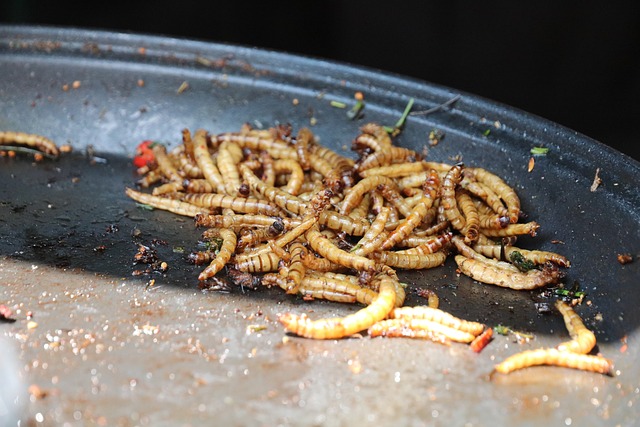
Feeding live mealworms to blue jays is an additional quick method for attracting them to your backyard.
Mealworms are quite similar to the food that birds eat in their native habitat; therefore, this is an excellent option.
They can’t resist the smell of the meal. Blue jays prefer the flavor of fresh mealworms because of their higher nutritional value.
Mealworms that are still alive can be helpful during the summer and spring months. They won’t be able to withstand the cold for very long.
Because live mealworms are so expensive, you don’t want to waste your cash away on anything that isn’t absolutely necessary.
Dry mealworms are another alternative that is less expensive. They’re stored and dried like jerky.
Mealworms that have been dried out are ideal for usage during the colder months since they can be stored for many days.
They are also less expensive since it is simpler to manufacture them in large quantities. Blue jays may get their necessary nutrients from mealworms.
They are chock full of protein, in addition to fat and fiber. Although the quantity of nutrition that is included in dried mealworms is fixed, the amount of nutrition that is contained in live mealworms may be increased for blue jays.
Conclusion
If you can provide for the blue jays’ fundamental elements, you won’t have any trouble luring them into your backyard.
Blue jays are dependent on having access to food, water, and a safe place.
You may entice blue jays to nest in your backyard by providing them with the proper food, keeping the water circulating, and planting trees of the oak, beech, or coniferous kind.
If you want blue jays to visit your backyard and keep them secure from other animals, you may do so by following the advice given above.
FAQ
Is it true that blue jays are aggressive, dominant birds?
Blue jay is one of the brashest bird species. If you’re one of the many who find them too outspoken or annoying at first, maybe you should give them another try. They have a common ancestor with the crow family, the corvids, and are likewise very intelligent.
Is the blue jay a bird that will approach people for food?
It’s amazing to see a Blue Jay up and personal; they’re such bold, intelligent birds who clearly have no fear of people. In fact, they are among the smartest birds you can observe in your yard. They belong to the corvid family with other jays like the Steller’s Jay, as well as other birds like crows, ravens, and magpies.
Where should a feeder for blue jays be placed?
Nevertheless, you need to check that the birdbath you are building is broad and spacious enough to serve the birds in question. Put up a heated birdbath for them to use throughout the winter months. The placement of the feeder is important because, as was said previously, blue jays like to eat their food while sitting in the vicinity of bushes.
Last Updated on March 22, 2023 by Lily Aldrin
